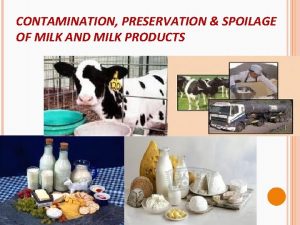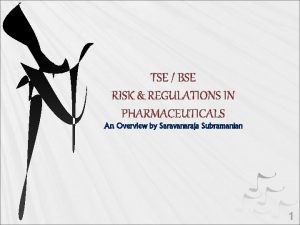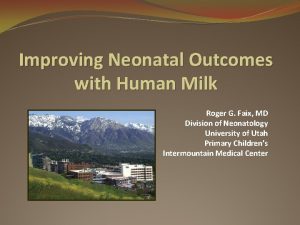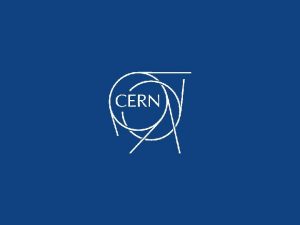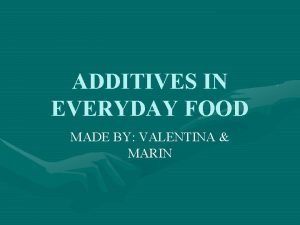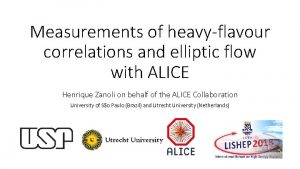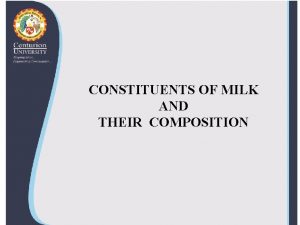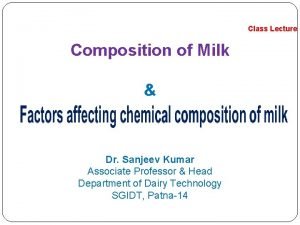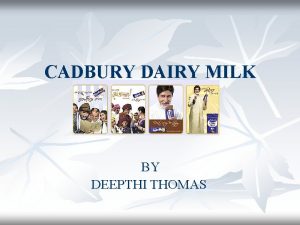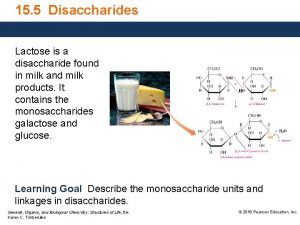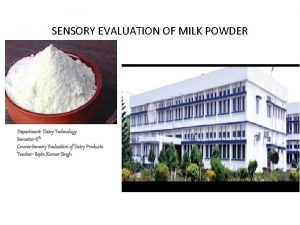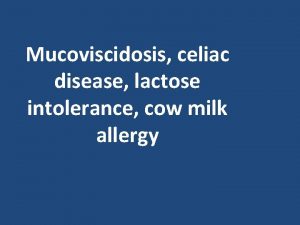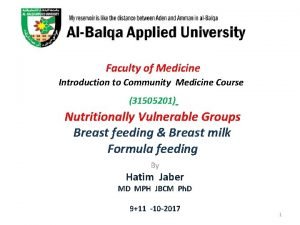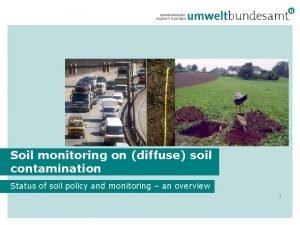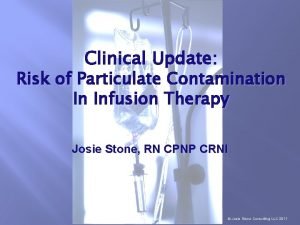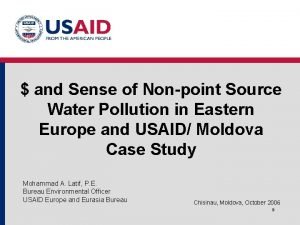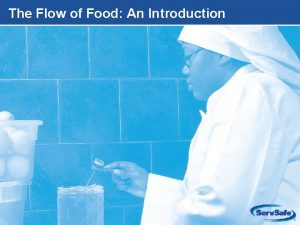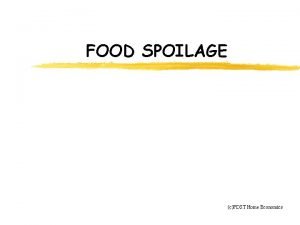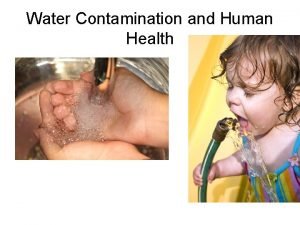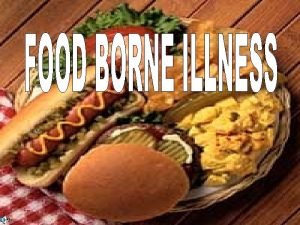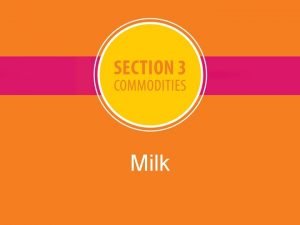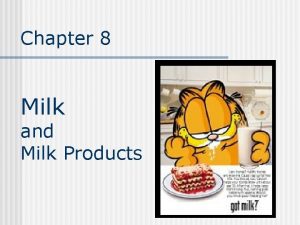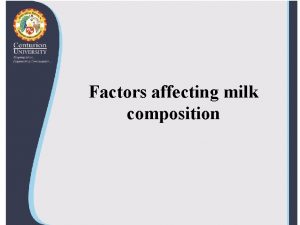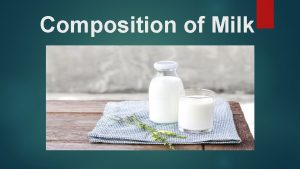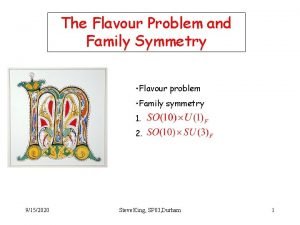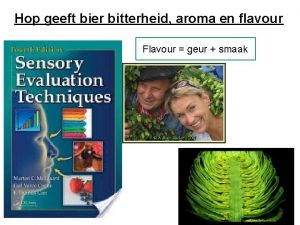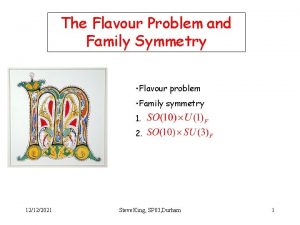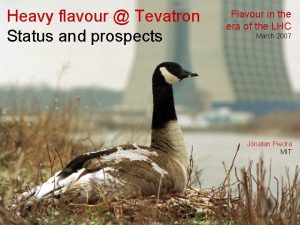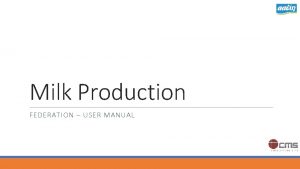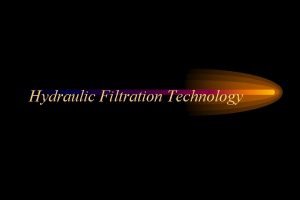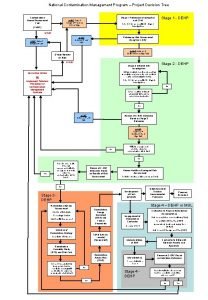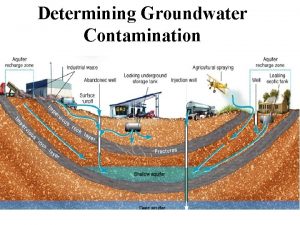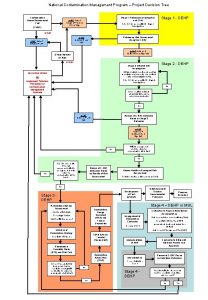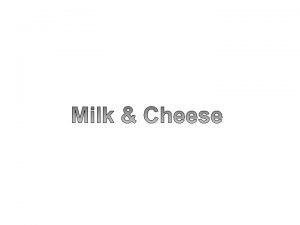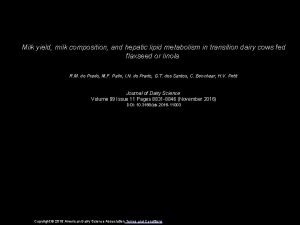MILK COMPOSITION OF MILK FLAVOUR OF MILK CONTAMINATION




























- Slides: 28

MILK § § § § § COMPOSITION OF MILK FLAVOUR OF MILK CONTAMINATION OF MILK AND MILK PRODUCTS PHYSICAL PROPERTIES OF MILK TYPES OF MICRO-ORGANISMS IN MILK NON-FERMENTED MILK PRODUCTS MILK PROCESSING STORAGE TIPS

COMPOSITION OF MILK Water: 87 -88% Carbohydrate: (approx. 5% ) • Mainly Lactose • In heated milk products, e. g. , in condensed milk, there is also lactulose which is a little sweeter’ Fat: 3 -4% in whole milk; • Contains fat soluble vitamins, pigment carotene & Xanthophylls; contains cholesterol & phospholipids but is primarily TGs(95%) • The fat in milk occurs in the form of droplets or globules, surrounded by a membrane and emulsified in the milk serum part (the whey part or the watery part). • Milk is an emulsion which is not naturally physically stable that is why creaming occurs if it is left to stand.

PROTEIN: (3 -4%) Casein (80% of milk protein) • The casein is arranged in super-structures called micelles, which consist of protein together with phosphate, citrate and calcium. • The caseins are actually a group of similar proteins, which can be separated from the other milk proteins by acidification to a p. H of 4. 6 (Ip) • The casein micelles also may be coagulated by addition of the enzyme rennin. Whey proteins (20% of milk protein) • lactalbumin, lactoglobulin & immunoglobulin • Whey proteins are more hydrated than casein and are denatured and precipitated by heat rather than by acid. Other protein components include enzymes such as lipase, protease, & alkaline phosphatase, which hydrolyses TGs, proteins, & phosphate esters, respectively. •

VITAMINS AND MINERALS Vitamins • Vitamins A, B 6, B 12, C, D, K, E, thiamine, niacin, biotin, riboflavin, folates, and pantothenic acid. • Vitamin A is naturally in the fat component of whole milk and more may be added prior to sale. • whole milk is generally (98%) fortified with vitamin D because it is naturally present only in small amounts. • Low-fat and non-fat milk are fortified with both of these fatsoluble vitamins because milk fat is reduced or absent. Minerals • Ca & P approx. 1% of milk • Ca is present as calcium caseinate, calcium phosphate & calcium citrate. • Other minerals present are chloride, magnesium, potassium, sodium, and sulfur.

FLAVOR OF MILK The flavour of milk is mild & slightly sweet. The characteristic mouth-feel is due to the presence of emulsified fat, colloidally dispersed proteins, the carbohydrate lactose, & milk salts. • Fresh milk contains acetone, acetaldehyde, methyl ketones, & SFAs that provide aroma. • “Flavour treatment” to standardize the odour and flavour typically follows pasteurization. In this treatment process, milk is instantly heated to 195 F (91 C) with live steam (injected directly into the product), and subsequently subject to a vacuum that removes volatile off-flavours and evaporates excess water produced from the steam.

FLAVOR OF MILK Less desirable, “barny” or rancid flavours, or other “offflavours, ” may be due to the following: • Slightly “cooked” flavour from excessive pasteurization temperatures. • Animal feed, including ragweed and other weeds, or wild onion from the field. • Lipase activity causes rancidity of the fat, unless destroyed by the heat of pasteurization. (Or, the short-chain butyric acid may produce an off-odour or off-flavour due to bacteria rather than lipase in the emulsified water of milk. • Light-induced flavour changes in the proteins and riboflavin because vitamin B 2 acts as a photosynthesizer. • Stage of lactation of the cow.

CONTAMINATION OF MILK AND MILK PRODUCTS • Milk is sterile at secretion in the udder but is contaminated by bacteria even before it leaves the udder. • Further infection of the milk by microorganisms can take place during milking, handling, storage, and other pre-processing activities.

FEW TYPES OF MICRO-ORGANISMS FOUND IN MILK

PHYSICAL PROPERTIES OF MILK ØAcidity: fresh milk p. H is 6. 5 -6. 7 at 25°C ØViscosity: depends on the amount of fat, size of fat globules & extent of clustering of Homogenization & ageing ↑ the viscosity globules. ØFreezing point: -0. 55°C addition of 1% of water to milk ↓ FP by -0. 0055°C. ØBoiling point: 100. 2°C

NON-FERMENTED MILK PRODUCTS Whey protein concentrate: ultra-filteration technology is used to concentrate protein in whey to various levels between 2080%. Skim milk: Fat content reduced to 0. 5 -2 % by centrifugation. Extensive use in bakery & confectionery. Also used for low calorie diets & children who need high protein. Evaporated milk: 50 -60% water evaporated, clarified raw milk is concentrated in vaccum pan at 74 -77°C. Fortified with Vit D, sterilised in cans at 118°C for 15 minutes & cooled. Condensed milk should contain 26% milk solids of which 8% is fat. Sweetened condensed milk: Made from pasteurized milk concentrated 7 sweetened with 65% sucrose. Contains 9% fat out of 31% milk solids.

NON-FERMENTED MILK PRODUCTS Toned milk: Mix of reconstituted from skim milk powder with buffalo milk. Fat content 5% & SNF 8. 5% Double toned milk: A mixture of cow’s or buffalo’s milk or both with fresh skimmed milk or by admixture with skim milk reconstituted from skim milk powder. Should be pasteurised. Fat content 1. 5% & SNF 9% Recombined milk: Homogenised product prepared from milk fat, SNF & water. Pasteurised. Fat content 3% & SNF 8. 5% Filled milk: Homogenised product prepared from refined vegetable oil & SNF & water. Fat content 3% & SNF 8. 5%

NON-FERMENTED MILK PRODUCTS • Malted Milk is a powdered gruel made from a mixture of malted barley, wheat flour, and whole milk, which is evaporated until it forms a powder. Malt powder comes in two forms: v Diastatic malt contains enzymes that break down starch into sugar; this is the form bakers add to bread dough to help the dough rise and create a good crust. v Non-diastatic malt has no active enzymes and is used primarily for flavor, mostly in beverages. It sometimes contains sugar, coloring agents, and other additives. • A lactose-free milk is available for people who are lactose intolerant. This modified milk is made by filtering regular milk to remove half the lactose. The enzmye lactase is then added to the milk to break down the remaining lactose into simpler forms which the body can absorb. • Flavored milk

NON-FERMENTED MILK PRODUCTS UHT processed milk: Packed & aseptically sealed in presterilized containers under aseptic conditions. • can be stored Unrefrigerated for atleast 3 months. • Cooked flavour due to denaturation of β-lactoglobulin. Standardised milk: Fat is maintained 4. 5% and SNF 8. 5%. Mix of buffalo & skim milk Dry milk: Made with whole milk or skimmed milk dehydrated to about 97% by spray drying & vaccum drying. Good shelf life. Highly hygroscopic & can be reconstituted to fluid milk. Khoa: Semi-solid obtained from milk by evaporating in open pans with continuous stirring in circular motion. Yield is about 20% of weight of milk used

NON-FERMENTED MILK PRODUCTS • Rabri: Concentrated sweetened product comprising several layers of clotted cream. Sugar is added to milk reduced to 1/3 of its original volume. • Chhena: Major heat & acid coagulated product. Used in sweets like rasmalai, rasogolla, etc. • Ice-cream: Frozen dairy product consisting of whole milk, skim milk, cream, butter, condensed milk products or dried milk products. Also contains sugar, stabiliser, emulsifier, flavoring material, water & air. v Sugar provides sweetness, smoothness & lowers the freezing point. v Stabiliser prevent formation of ice crystals. Forms gel with water & thereby improve body & texture. e. g. , gelatin, sea weed, china grass & CMC. v Emulsifier help disperse fat globules throughout the mix & prevent clump formation, further help make ice-cream dry & stiff.

CREAM Cream is the high-fat component separated from whole milk as a result of the creaming process. It has a higher proportion of fat droplets to milk than regular fluid milk; and according to federal standards of identity, cream must contain 18% milk fat or more. Due to this high fat content of cream compared to milk, some yellow, fat soluble pigments may be apparent. Various liquid creams available for use in foods include the following: v Light (coffee) cream: 18– 30% butterfat. v Light whipping cream: 30– 36% butterfat. v Heavy cream: 36% butterfat, minimum. v “Half-and-half” cream diluted with non-fat milk: 10. 5% butterfat. v Whipping cream packaged under pressure in aerosol cans; may be non-fat or contain various levels of fat, sugar, flavouring, emulsifiers, and a stabilizer.

FERMENTED MILK PRODUCTS Butter v. Fat content is generally about 80%. v. Made from sweet or sour cream. v. Butter is a concentrated form of fluid milk produced through churning of pasteurized cream. Churning involves agitation that breaks fat globule membranes so the emulsion breaks, fat coalesces, and water (buttermilk) escapes. v. Milk is churned to form butter and the watery buttermilk. Butter may have a yellow color due to the fat-soluble animal pigment, carotene, or an additive. v. Butter spoil as a result of hydrolysis of TG molecules releasing free butyric & caproic acids.

FERMENTED MILK PRODUCTS Ghee A type of clarified butter, is prepared by simmering butter and removing the residue. The texture, colour, and taste of ghee depend on the quality of the butter and the duration of the boiling. Buttermilk was the liquid left behind after churning butter out of cream. It is beneficial to health as it contains probiotic microbes also fat content of buttermilk is far lower than milk or curd.

FERMENTED MILK PRODUCTS Curd Prepared by cooling boiled milk to body temperature & adding 5 -10% starter. After 6 -8 hours an acidity of 0. 9 -1% is formed which coagulate the casein & curd is set. Easily digested than normal milk. Contains more vitamin B than milk. Used as marinating & souring agent in cookery. Yogurt is a variety of curd. Whole, low fat, skim milks & even cream can be used to make yogurt. In production of yogurt, a mixed culture of streptococcus thermophilus, lactobacillus acidophilus is usually added to to the pasteurised milk & incubated at 42 -46°C. • Increase in folic acid concentration during fermentation. • Fermented milk is useful for a wide variety of disorders like colitis, constipation, diarrhoea, gastroenteritis, diabetes & hyper cholesteremia. Shrikhand: Fermented product made by concentrating dahi by removing whey & to which sugar, flavor & condiments are added.

FERMENTED MILK PRODUCTS Cheese is made up of casein. Varieties of cheese are differentiated according to their v Flavour v Texture v Type of milk v Salts & seasoning added v Type of bacteria & mould species used in ripening v Manufacturing & processing method

MILK PROCESSING 1. 2. 3. 4. 5. 6. Clarification Homogenization Pasteurization Fortification Bleaching Dehydration Processing is done to produce milk of low bacterial count, good flavor & sufficient keeping Quality.

CLARIFICATION AND CLEARING v Clarification: Removal of small particles - straw, hair etc. from milk based on density v “Bactofugation”: Centrifugal separation of microorganisms from milk: – Bacteria and particularly spores have higher density than milk – Two-stage centrifugation can reduce spore loads up to >99% – Optimal temperature for clarification is 55 -60ºC v Microfiltration: – Micro-filter membranes of 1. 4 micro meter or less can lead to reduction of bacteria and spores up to 99. 5 -99. 99%.

HOMOGENIZATION • Function : To prevent creaming, or the rising of fat to the top of the container of milk. • The process of homogenization permanently emulsifies the fine fat globules by a method that pumps milk under high pressure [2000– 2500 lb/in 2 (psi)] through small mesh orifices of a homogenizer. • Homogenization mechanically increases the number & reduces the size of the fat globules. The size is reduced to 1/10 of their original size. • Resulting in the milk that maintains more uniform composition with improved body and texture, a whiter appearance, richer flavor, & more digestible curd.

PASTEURIZATION Pasteurisation is a relatively mild heat treatment, sufficient to destroy disease causing microorganisms and inactivate enzymes to extend its shelf life. • It should be followed by immediate cooling of product to the temp. sufficiently low to check the growth of microorganisms which are resistant to temp. used. • Pasteurisation causes minimal sensory and nutritive changes in the food. Some vitamin levels are reduced, mainly vit B 1 & vit C.

DIFFERENT PASTEURIZATION METHODS

ALKALINE PHOSPHATASE TEST: • Enzyme Alkaline Phosphatase present in raw milk serves as a built-in-indicator to gauge the adequacy of pasteurisation. • Inadequate pasteurization of raw milk reveals the presence of a high alkaline phosphatase activity. • It is so sensitive that it gives positive in presence of 0. 1% raw milk added or if the pasteurisation temp. is less by 1 degree F.

FORTIFICATION AND BLEACHING • Fortification The addition of fat-soluble vitamins A and D to whole milk is optional but must for Lowfat milk & non-fat milk (usually before pasteurization). • Bleaching carotenoid or chlorophyll pigments in milk may be desirable. • The FDA allows benzoyl peroxide or a blend of it with potassium alum, calcium sulphate, or magnesium carbonate to be used as a bleaching agent in milk. • Vitamin A or its precursors may be destroyed in the bleaching process; therefore, sufficient vitamin A is added into the milk, or in the case of cheese making to the curd.

DEHYDRATION

STORAGE TIPS • Refrigerate as soon as possible • Use milk in order of purchase from individual refrigerators atvhome. (Put freshest milk in the back and use the oldest first) • Chill UHT milk before serving. Refrigerate after opened. • Dry milk should be refrigerated after reconstituted • Do not pour unused milk back into original container • Close container so milk will not absorb flavors • Canned milk - store in cool, dry place
 Contamination of milk and milk products
Contamination of milk and milk products Tse vs bse
Tse vs bse Contamination vs cross contamination
Contamination vs cross contamination Cow milk vs breast milk
Cow milk vs breast milk Heavy flavour
Heavy flavour Condor job flavour
Condor job flavour Flavour enhancer 627 and 631 side effects
Flavour enhancer 627 and 631 side effects Heavy flavour
Heavy flavour Composition of milk
Composition of milk Composition of milk
Composition of milk Milk yield and composition in dairy cows ppt
Milk yield and composition in dairy cows ppt A disaccharide found in milk and milk products
A disaccharide found in milk and milk products Sensory evaluation of milk and milk products
Sensory evaluation of milk and milk products Milk for toddlers with milk allergynon dairy
Milk for toddlers with milk allergynon dairy Human milk vs cow milk
Human milk vs cow milk Soil contamination monitoring
Soil contamination monitoring Contamination and deficiency of a job performance measure
Contamination and deficiency of a job performance measure Arc welding objectives
Arc welding objectives Four f's of food contamination
Four f's of food contamination The three types of hazards that make food unsafe are
The three types of hazards that make food unsafe are Particulate contamination in infusions
Particulate contamination in infusions Irradiation vs contamination
Irradiation vs contamination Point source pollution examples
Point source pollution examples Observed by
Observed by Physical and procedural barriers of cross contamination
Physical and procedural barriers of cross contamination Reason of food spoilage
Reason of food spoilage Silicone contamination aerospace
Silicone contamination aerospace Snr formula
Snr formula Personality-related position requirements form
Personality-related position requirements form
